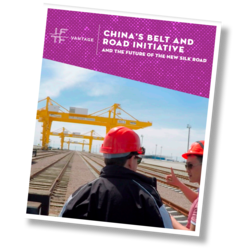China’s Belt and Road Initiative

No country’s world role has changed more dramatically in recent decades than China’s ...
 From relative poverty and obscurity, China has risen to have the second largest economy in the world, a permanent seat on the United Nations Security Council, the largest standing army in the world, and private sector companies that are among the world’s largest and most innovative. In the last few years, China’s strategic positioning toward the rest of the world has started to shift as well, facing dramatically outward. In fact, Chinese president Xi Jinping gave this burgeoning movement a name when he officially launched it in 2013—the Belt and Road Initiative (BRI).
From relative poverty and obscurity, China has risen to have the second largest economy in the world, a permanent seat on the United Nations Security Council, the largest standing army in the world, and private sector companies that are among the world’s largest and most innovative. In the last few years, China’s strategic positioning toward the rest of the world has started to shift as well, facing dramatically outward. In fact, Chinese president Xi Jinping gave this burgeoning movement a name when he officially launched it in 2013—the Belt and Road Initiative (BRI).
Explaining what this initiative is can at times be blurry. It is best understood as a vision—one of international cooperation, with China in the center. It encompasses infrastructure projects, financial agreements, and diplomatic engagements with over 150 countries. Its motives and incentives are complex and difficult to generalize.
What we can say is that these relationships will profoundly affect the development of the world economy, geopolitics, technology, and culture in the upcoming decades and throughout the 21st century.
Three Lenses on the Belt and Road Initiative
The BRI’s impact occurs at different levels, affecting global infrastructure, geopolitics, international business and economics, interpersonal relationships, and more. Borrowing from Kenneth Waltz’s classic book Man, the State, and War, we use “three lenses” to examine the BRI in this report from IFTF Vantage in 2019:
- Through the widest lens, we look at China’s expansive infrastructure and geopolitical push beyond its borders.
- Through a second lens we examine China’s exportation of economics and business.
- Lastly, we take a close up look at how the BRI is impacting cross-cultural relationships on a personal level.
Using these three lenses provides a comprehensive way to make sense of this variety of potential impacts. Regardless of whether the intentions of the Belt and Road Initiative bear fruit or another future emerges, the BRI’s impacts will be felt for many decades—in some of the fastest growing cities and countries in the world.
This primer is designed to help you dig beneath the surface of the BRI, explore the large-scale efforts and personal-scale impacts, and identify insights about what this global effort means to your organization.
See videos of the panel discussion from IFTF TYF 2019 with Jeremy Kirshbaum. >>
Acknowledgements
Lead Author:
Jeremy Kirshbaum, Research Affiliate, Institute for the Future and founder of Handshake, LLC
Contributing Authors:
Anum Ahmed
Joseph Andrews
Editors:
Mark Frauenfelder
Bradley Kreit
Carla Sinclair
Expert Advisors:
Ruslan Turarov, Kazakh Invest, Kazakhstan
Nael Hailemariam, Director, Design Ethiopia, Ethiopia
General Patadui, Major General Pakistan Army (retired), Pakistan
Nara Zhou, Partner, Yingke Global, China
Olushola Adelana, Lekki Free Zone Development Company, Nigeria
David Li, Shenzhen Open Innovation Lab, China
Leslie Zhan, Hanton Trading Co. Ltd., China
Get in touch!
Interested in engaging with early research exclusively available to IFTF Vantage partners?
John Clamme | [email protected] | 650-233-9517



